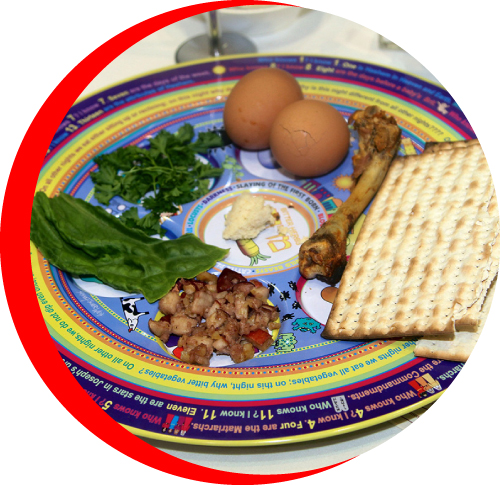



Seder plate
COURTESY MOUNT BETHEL UMC, MARIETTA, GA.

The Rev. K Karpen and Rabbi Roly Matalon speak to children at B’nai Jeshurun Hebrew School in New York City.
COURTESY PHOTO
“The Passover is not about just telling the Exodus story,” says Rabbi Evan Moffic. “It is about reliving it.” Senior rabbi of Congregation Solel in Highland Park, Ill., Moffic recently wrote What Every Christian Needs to Know about Passover: What It Means and Why It Matters (Abingdon Press).
He describes the Passover meal as “one of the interesting places that Judaism and Christianity intersect – intersections that are, at once, rich, complicated, winsome, and sometimes fraught. Jews – even Jews who observe very few other religious rituals – celebrate a Passover seder each year, a meal that commemorates the events of the original Exodus from Egypt.”
Celebrating a seder is more than gathering supplies – matzah, bitter herbs, charoset, a roasted bone, a hard-boiled or roasted egg, parsley, saltwater and wine or grape juice – and reciting the Passover story. It is a spiritual experience that can enrich one’s faith.
Moffic encourages Christian congregations to consider having a seder with their Jewish neighbors. By doing so, he says, “Christians can learn about the roots of several Christian practices as well as some of the depth of Jewishness in Jesus’ teachings. Jews can learn a great deal of spirituality and contemporary worship from Christians. The possibilities are endless.”
Sharing meals, sharing mission
The United Methodist Church of St. Paul and St. Andrew on New York’s Upper West Side knows firsthand how valuable that sharing can be. The United Methodists have shared a building and a life with the Jewish Congregation B’nai Jeshurun since 1991.
“Early on,” recalls the Rev. K Karpen, senior pastor at St. Paul and St. Andrew, “we held Passover seders with B’nai Jeshurun. The rabbis created and led the Haggadah (storytelling). We pastors joined in the singing and eating!” Participants from both faiths led the readings.
The seders led to other shared experiences.
While the two congregations have not recently celebrated Passover together, B’nai Jeshurun families have invited Karpen and others from St. Paul and St. Andrew to join them for seders in their homes.
“One time, we went to the home of one of the rabbis, Roly Matalon, and his wonderful family,” Karpen remembers. “They had also invited several Muslim friends. I think that the Jewish participants came away with how powerful and important the Exodus is in Christian tradition. The United Methodists were struck with different aspects of the ritual – for instance, spilling drops of wine in memory of the suffering of the Egyptian soldiers and their families at the drowning in the Red Sea. That made us more aware and sensitive to the many ‘enemies’ who suffer as a result of our participation in war.”
One United Methodist participant told him, “At events like this, it’s so important to be a ‘perfect stranger,’ learning and taking the lead from our hosts.”
The seders have led to other interfaith ventures such as regularly scheduled themed meals with St. Paul and St. Andrew, B’nai Jeshurun and two Muslim groups.
“We do it potluck,” Karpen says, “all vegetarian, because of the Jews and Muslims; no alcohol, because of the Muslims and United Methodists!” They also hold interfaith worship services on special occasions, run a homeless shelter together and cooperate in a large emergency-food program and a tutoring project.
“I think our Wesleyan tradition really helps with things like this,” Karpen says. “John Wesley, for all his evangelical fervor and Christian conviction, knew how to be respectful and appreciative of other religious traditions.”
“Occasionally,” author Moffic tells Interpreter, “Christians only see Passover through a Christian lens.” In his book, he points to the Jewish and Christian parallels.
“Churchgoing Christians celebrate Jesus’ Passover seder when they take Communion,” he writes, “and many Christian communities specifically recall Jesus’ last Supper on Holy Thursday, the Thursday before Easter.”
“The seder plate is to Passover dinner what the chalice and paten are to the celebration of Communion, and the special foods on the seder plate are, in some ways, like the bread and the wine that the chalice and paten hold.”
The Passover story, says Moffic, “is not just a part of Jewish history. It delivers a universal message of hope.”
Barbara Dunlap-Berg is associate editor of Interpreter magazine.
From The Book of Worship
The following is guidance from The United Methodist Book of Worship (1992) concerning United Methodists participation in Seder meals. “United Methodists are encouraged to celebrate the Seder as invited guests in a Jewish home or in consultation with representatives of the Jewish community, thus respecting the integrity of what is a Jewish tradition and continuing the worthy practice of Jews and Christians sharing at table together. Celebrating the modern meal without a Jewish family as host is an affront to Jewish tradition and sometimes creates misunderstanding about the meaning of the Lord’s Supper”.
